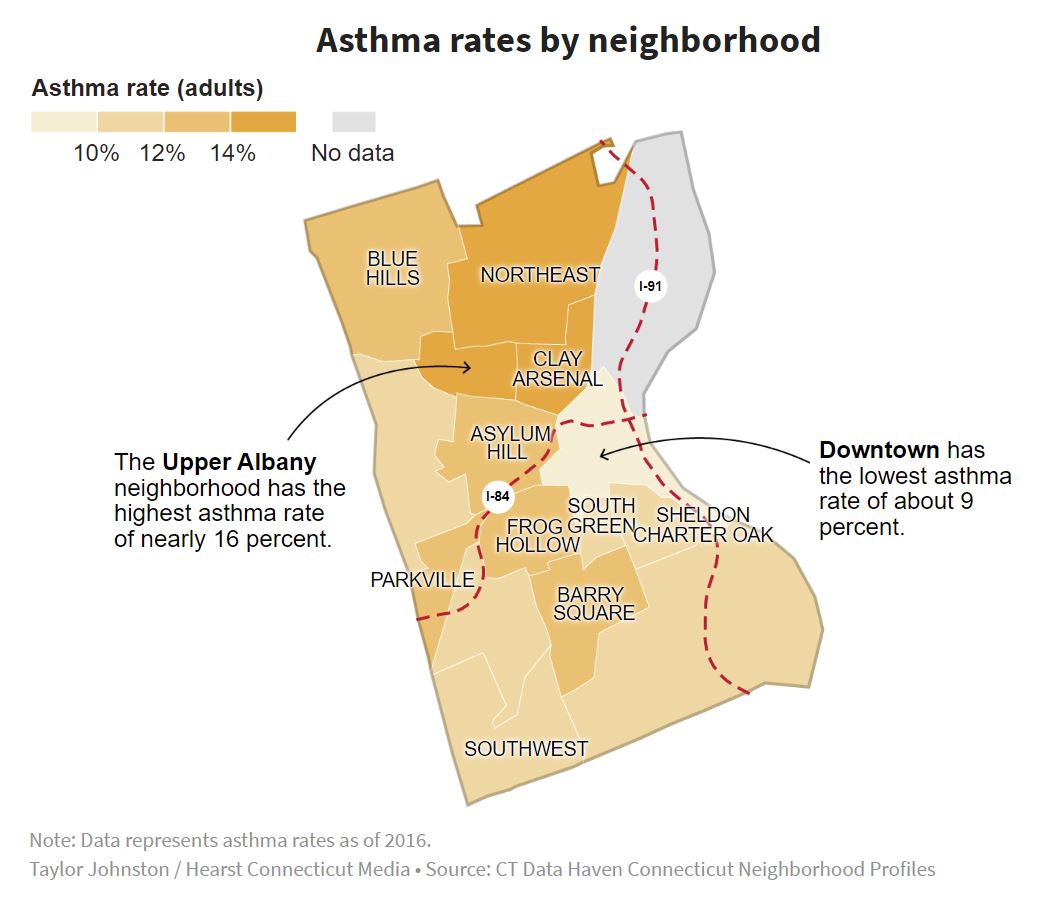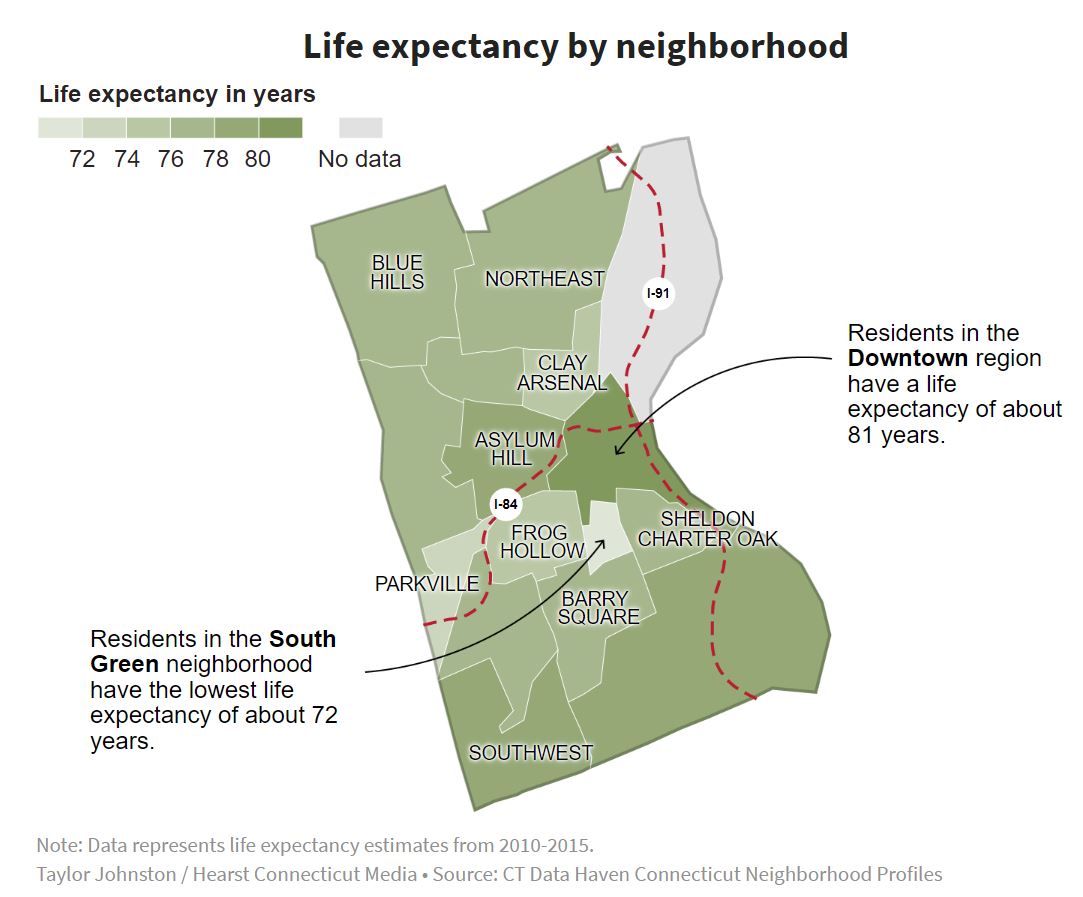All DataHaven Programs, Demographics, Economy
Living with the Highway: Hartford residents navigate the divide caused by Connecticut’s urban highways
[Excerpt from feature article by Emily DiSalvo and Taylor Johnston, 2/4/2023]
As far as Elijah Hilliman can tell, I-84 “was built to get people out of Hartford.” Like Dunkin’ Donuts Park, a minor league baseball stadium across the street from his coffee shop, Hilliman says the highway wasn’t built for residents of Hartford.
“It cuts, specifically, the North End of Hartford off,” Hilliman said. “So, in that aspect, it’s very racially motivated. So, the North End is all Black people. We don’t have access to pretty much anything.”
Hilliman, who left Hartford for Seattle but returned to his childhood home to open Semilla Cafe + Studio on Main Street, hasn’t let the divide created when the highway was built in the 1960s stand in his way as he connects his community today.
“A small locally owned coffee shop,” Hilliman said, “it doesn’t seem like a big thing, but for a city that lacks so many resources, it is huge. We’re building a coffee shop, but how do we build a coffee shop with intention? It’s wanting to prioritize people and creatives already here.”
Hilliman’s coffee shop sits small in the shadow of Dunkin Donuts Park, but it’s one of many homegrown businesses across the city that could bring people into Hartford. Still, from Hilliman’s view north of I-84, the highway is big.
[….]
Critiques of these highways extend all the way to Capitol Hill. U.S. Rep. John B. Larson, D-1st District has been an outspoken advocate of highway improvements in Hartford.
“Interstates I-84 and I-91 in and around Hartford are among the country’s most egregious highway designs,” Larson said in a statement.
The engineers involved in the Greater Hartford Mobility Study, which is ongoing, said the research is taking into account the lived experiences of residents impacted by the highway, but a policy misstep could have consequences that perpetuate the roadway’s dominance over the city.
For example, in West Hartford, Connecticut DOT is already working on a project that would add a lane to I-84 to reduce congestion. Anthony Cherolis, former program manager at the Center for Latino Progress/Transport Hartford Academy, fears a similar outcome of the Greater Hartford Mobility Study — more lanes of traffic, consuming more space and increasing the ease of suburban access to the city, choosing suburban visitors over Hartford residents.
“Instead of alleviating congestion with bus, rapid transit lanes, tolls, infill development, improved evening and weekend transit, they’re looking to solve it with extremely expensive, polluting interstate widening. It’s part of furthering the sins of the past,” Cherolis said.
[….]
The Clay Arsenal neighborhood, one of four neighborhoods in the North End, has the highest poverty rate not only in Hartford but in any of Connecticut’s major cities, with 43 percent of residents below the poverty line. Data also show rates of asthma and high blood pressure tend to be elevated in neighborhoods in the city’s North End, while overall life expectancy tends to be lower.
All four neighborhoods with asthma rates higher than Hartford’s overall 12 percent were North End neighborhoods, with Upper Albany showing a 15 percent asthma rate. Hartford’s Downtown has the lowest asthma rate of any neighborhood in the city, a fact Mark Abraham of DataHaven said could be attributed to the neighborhood’s transient population. Parkville matched the city as a whole with a 12 percent asthma rate in 2019. Asthma isn’t the only health affliction facing Hartford residents.
A startling 44 percent of residents in the Upper Albany neighborhood have high blood pressure, 10 percentage points higher than Hartford’s average and greater than any other neighborhood in the city. The Northeast neighborhood is a close second, with 42 percent of residents with high blood pressure. There are many causes of high blood pressure and many questions about the health effects of highways that scientists are studying. A study in Stockholm revealed that living near a highway could increase the risk of a heart attack by 69 percent. The increased risk could be driven by ultrafine particles from carbon soot, metal and pieces of tire the size of viruses.
Life expectancy in Hartford is more than three years below Connecticut’s life expectancy rate, according to DataHaven research. Within Hartford, the South Green neighborhood has the lowest life expectancy. A close second? Parkville with a life expectancy of 73.7 years. The third lowest life expectancy was found in Clay Arsenal. Not one North End neighborhood surpassed the city’s average life expectancy of 77.1 years. Hartford Mayor Luke Bronin said air pollution from vehicles traveling on the highways might negatively affect residents’ health.
[….]


